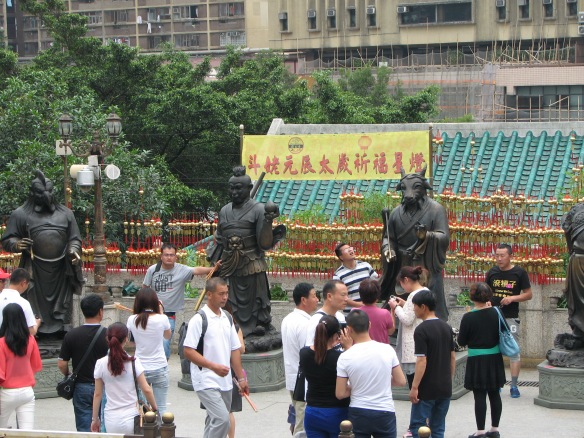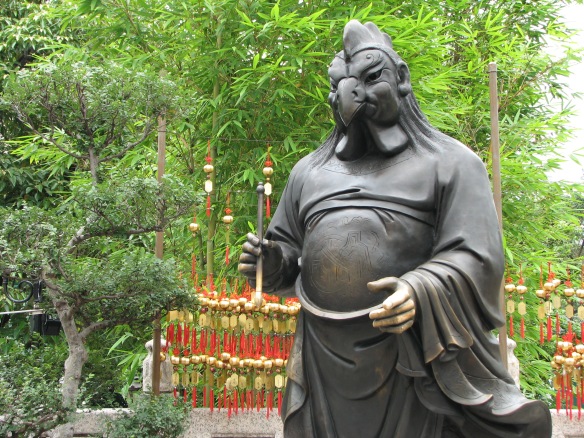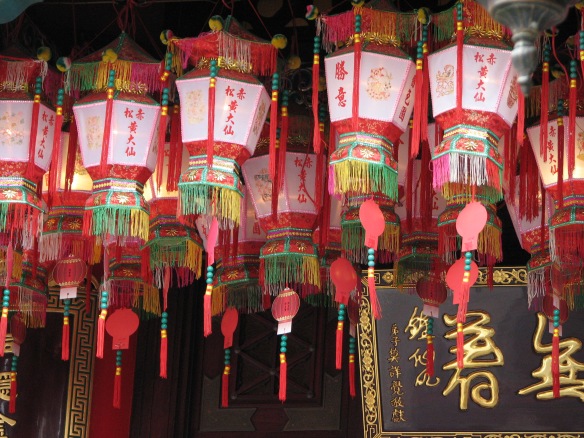I was going to tell you about Malaysian Borneo when I got sidetracked by their neighbor Brunei. Moving on quickly (which is what we did as we flew over the sultanate on our way to the state of Sarawak), we landed in Kuching. What a lovely, lovely city. Kuching should get its own post, and likely will. We roamed along the riverfront walk and slurped down laksa noodle dishes with gusto. Kuching is a great spot to head out to various national parks to see wildlife.
Borneo is home of the native Dayak tribes. Remember childhood tales of the wild headhunters of Borneo? The Dayak call this ritual Ngayau. We visited Dayak long houses. Smoked skulls still hang at the hearth in the central long house.
The most important tribal figure is the head chief, closely followed by the shaman. This medicine man, also known as a balian [1] is responsible for the health of the tribe as well as interceding between the worlds.
During our time in Kuching I’d been glancing in shops without actually entering any of them. Among the streets of tourist trinkets, one store fascinated me. On the last day I made a beeline for that shop. [2]
And then I made a beeline for a shelf lined with containers topped by human figures.
 Jerry Ang, the soft-spoken shop owner, kindly answered all my questions. He told me these were Dayak shaman medicine containers. The figures are hand carved from polished buffalo or cow bone. A shaman had hand-etched the jar with scrimshaw patterns. Dayak shamans used the containers to store herbs, magic powders and betal lime to make medical potions. Some still contained resins – Jerry and I opened each jar and sniffed.
Jerry Ang, the soft-spoken shop owner, kindly answered all my questions. He told me these were Dayak shaman medicine containers. The figures are hand carved from polished buffalo or cow bone. A shaman had hand-etched the jar with scrimshaw patterns. Dayak shamans used the containers to store herbs, magic powders and betal lime to make medical potions. Some still contained resins – Jerry and I opened each jar and sniffed.
The carved figure indicates the illness the potion was intended to treat. Some of the figures held their heads (aches and pains of the head) or their stomachs. Some figures even depicted a person crouched over… the traveler’s curse of diarrhea for sure.

My piece has a prawn carved on the back: Jerry thought maybe prawns were one of the main ingredients in the medicine. Or perhaps the prawn indicated the woman who made the potion (he said the figure was female), or an ancestor. An on-line source tells me the scrimshaw work represents animals that bring good luck. If anyone can give me more information, I’d be most grateful!
 NOTES: [1] Balian is the term used for traditional healers on Bali, too. Healing arts are passed down through generations. Twenty years ago I did a massage exchange with the son of a balian there; he had been taught by his father. To learn more about the Dayak shamans go to http://factsanddetails.com. The article gives the following information: “Shamanic curing, or balian, is one of the core features of these ritual practices. Because illness is thought to result in a loss of the soul, the ritual healing practices are devoted to its spiritual and ceremonial retrieval. In general, religious practices focus on the body, and on the health of the body politic more broadly. Sickness results from giving offense to one of the many spirits inhabiting the earth and fields, usually from a failure to sacrifice to them. The goal of the balian is to call back the wayward soul and restore the health of the community through trance, dance, and possession.” [Source: Library of Congress, 2006] Or see Wikipedia: The Dayak People [2] See also Unika Borneo, the shop where I found my figure. I receive no commission for mentioning the store. I just think they deserve to be mentioned. More figures can be admired at https://borneoartifact.com and https://www.esotericstuff.com
NOTES: [1] Balian is the term used for traditional healers on Bali, too. Healing arts are passed down through generations. Twenty years ago I did a massage exchange with the son of a balian there; he had been taught by his father. To learn more about the Dayak shamans go to http://factsanddetails.com. The article gives the following information: “Shamanic curing, or balian, is one of the core features of these ritual practices. Because illness is thought to result in a loss of the soul, the ritual healing practices are devoted to its spiritual and ceremonial retrieval. In general, religious practices focus on the body, and on the health of the body politic more broadly. Sickness results from giving offense to one of the many spirits inhabiting the earth and fields, usually from a failure to sacrifice to them. The goal of the balian is to call back the wayward soul and restore the health of the community through trance, dance, and possession.” [Source: Library of Congress, 2006] Or see Wikipedia: The Dayak People [2] See also Unika Borneo, the shop where I found my figure. I receive no commission for mentioning the store. I just think they deserve to be mentioned. More figures can be admired at https://borneoartifact.com and https://www.esotericstuff.com
© Jadi Campbell 2019. All photos © Uwe Hartmann. To see more of Uwe’s pics from our trips go to viewpics.de.
Click here for my author page to learn more about my books and me.








































